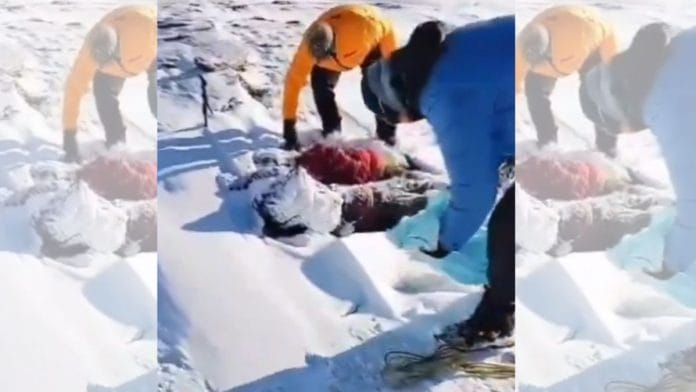The District Administration of Uttarkashi and the government of Uttarakhand are lauding what they claim to be the fastest rescue operation ever executed in the state. This involved planning the air rescue of nine bodies and 13 survivors from Sahastra Tal within two hours on the night of 4 June.
But the operation, indeed one of the quickest, highlights regulatory lapses in adventure tourism management in Uttarakhand.
Once the news broke that four individuals had died and others were trapped at around 4,500 metres near Sahastra Tal, the trek’s local guide called the secretary of the trekking association of Uttarkashi around 4 pm and also submitted a letter. The secretary informed the district magistrate’s office, which then involved the Uttarkashi District Disaster Management Authority (DDMA).
Mobilising the rescue effort
The DDMA officials confirmed the details within 10 minutes and deployed the ground rescue team, including state forest officials, the State Disaster Response Force (SDRF), and the Indo-Tibetan Border Police (ITBP). Given that the trekkers were from Karnataka, the Karnataka government was also informed, per general protocol.
When the Karnataka Mountaineering Association (KMA) was updated about the trapped trekkers at 6 pm, its first point of contact was an official at the Indian Mountaineering Foundation (IMF).
The IMF official, in turn, made a series of calls to the DM’s office, SDRF, and Nehru Institute of Mountaineering (NIM) principal already working on a rescue plan. The official also contacted the chief secretary of Karnataka for a helicopter rescue mission in the early hours of 5 June.
This was followed by communication between the chief secretaries of Karnataka and Uttarakhand, and the principal secretary of disaster management, Uttarakhand. The IMF stepped in and called the Uttarkashi DM to initiate a requisition for a helicopter rescue by the Indian Air Force (IAF) through the Ministry of Defence, which was swiftly carried out.
The DM’s requisition letter went out around 9:30 pm on 4 June, and the officiating joint secretary (air) in the Ministry of Defence was contacted. The Air Force (Western Air Command) approved the rescue sortie through Sarwasa.
Then Uttarakhand Chief Minister Pushkar Singh Dhami became directly involved, ensuring rapid mobilisation and a swift rescue. He also ordered a magisterial inquiry, prompting the first FIR against a local adventure tour operator.
On 4 June, four rescue teams from NIM, ITBP, SDRF, and the Uttarakhand government sports department set out on foot to locate the trekkers. The ITBP team intercepted two trekkers from the group as they were coming down.
The air mission commenced on 5 June at 7 am, initially deploying a private helicopter to transport SDRF rescue personnel to the high-altitude spot. Later, at 8:40 am, the IAF helicopters—one MI-17 and two Cheetahs—reached the Matli helipad in Uttarkashi. The air rescue operation was monitored by the combined efforts of IMF, DM, SSP, SDRF, and NIM officials.
Also read: How Uttarakhand trekking turned adventure into tragedy—cost-cutting, scant resources
Lapses in regulatory oversight
Under normal circumstances, mobilising such an extensive rescue effort would take at least 48-72 hours, underscoring the extraordinary swiftness of the operation.
However, it does raise several important questions. Firstly, why did it take a tragedy to prompt such a quick and comprehensive response? In this case, intense political pressure on the government ensured a rapid mobilisation of resources, but it should not be the sole catalyst for action.
The need for efficient and prompt rescue operations is not new; such measures should be standard protocol rather than an exception driven by political influence.
Moreover, the necessity of a magisterial inquiry indicates lapses in regulatory oversight. The incident also points to a broader need for stringent regulations and regular audits to ensure the safety of adventure enthusiasts.
Sources further indicate that the entire rescue operation cost approximately Rs 5 crore, making it a significant financial undertaking. While it is unclear who has borne this cost, it is understood from sources that the IMF has assured to cover the costs for airlifting survivors as well as the deceased.
While the rescue operation at Sahastra Tal shows the importance of responding quickly under pressure, it also highlights the need for systemic changes. The incident should serve as a wake-up call for the adventure tourism industry. Prioritising safety, accountability, and preparedness will prevent future tragedies.
After all, the human and financial costs of preparedness are far less than those of a rescue operation.
Anusha Subramanian is an independent journalist, mountaineer, and entrepreneur who has been writing specifically about adventure and mountaineering for over a decade. She posts under @sanushas. Views are personal.
(Edited by Prasanna Bachchhav)






